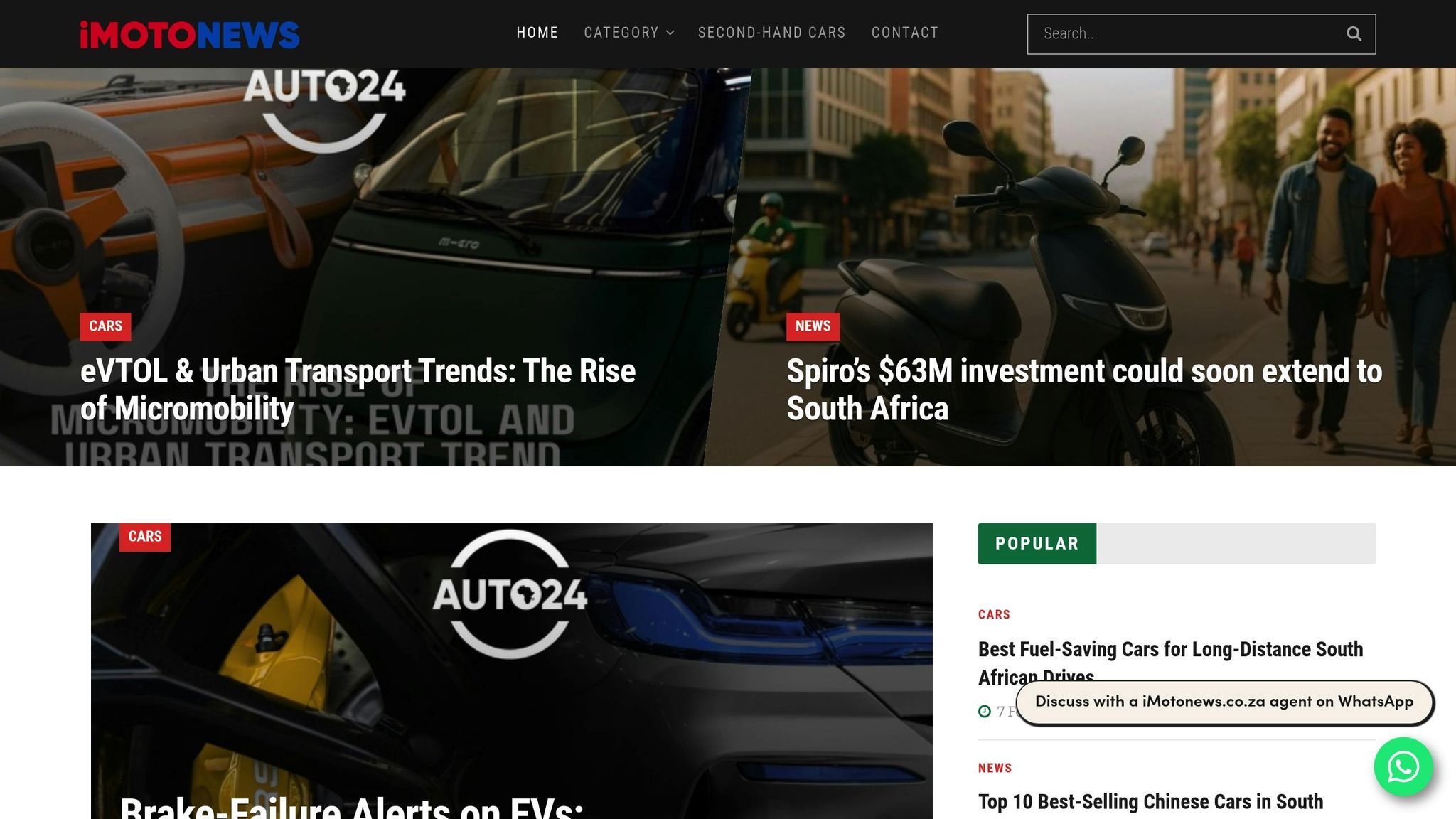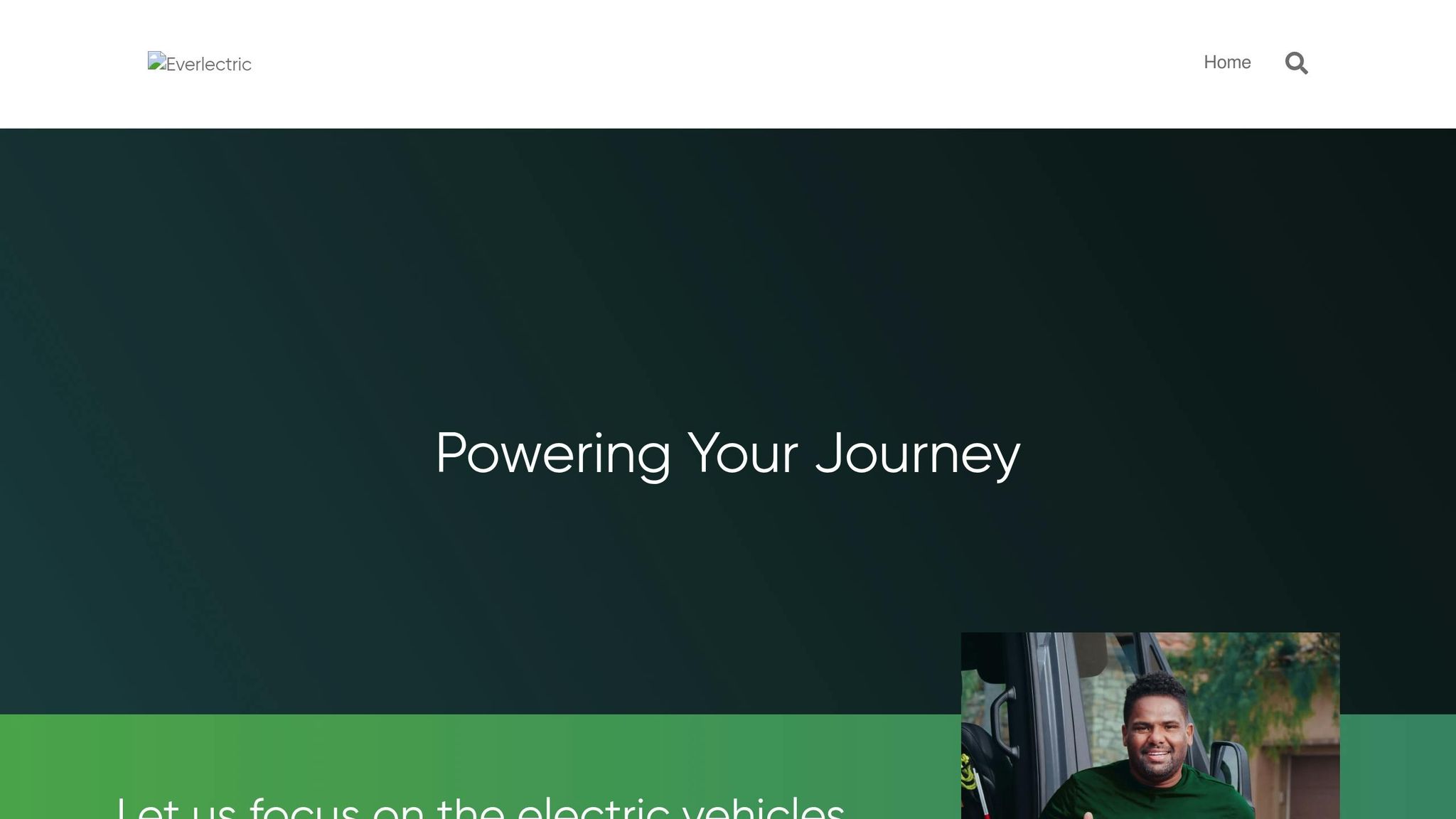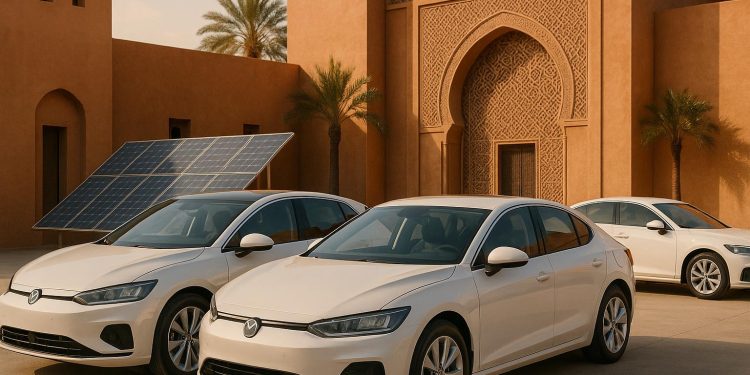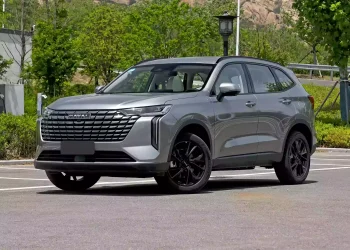South African fleet operators face two main challenges when adopting electric vehicles (EVs): high upfront costs and unreliable power supply. Morocco’s EV leasing model could be the solution. This approach separates the cost of the EV and its battery, reducing initial expenses and offering predictable monthly payments for battery services. Fleet operators benefit from battery swapping stations, minimizing downtime and sidestepping load shedding issues.
Key Takeaways:
- Cost Separation: Lower upfront costs by leasing batteries separately.
- Battery Swapping: Quick replacements reduce downtime compared to traditional charging.
- Grid Independence: Battery swap stations mitigate the impact of load shedding.
- Flexibility: Tailored lease terms and battery options cater to fleet needs.
To adopt this model, South African businesses should evaluate their fleet requirements, build partnerships with reliable service providers, and invest in charging infrastructure like solar-powered stations. Starting with small pilot programs can test the model’s feasibility before scaling. By addressing infrastructure and grid challenges, this approach can modernize fleets while managing costs effectively.
Key Features of Morocco’s EV Leasing Model
Separate Costs for Vehicle and Battery
One standout feature of Morocco’s EV leasing model is the decision to separate the costs of the vehicle from its battery. By leasing the battery through a dedicated service agreement, the upfront expense of electric vehicles becomes significantly lower. This approach not only makes EVs more accessible but also allows for more tailored leasing options and infrastructure solutions.
Flexible Leasing and Battery Options
The model offers a range of flexible lease terms and battery service agreements. Businesses can choose from various contract lengths, which is especially helpful for fleet operators wanting to experiment with shorter programs before committing to a full-scale rollout. This flexibility ensures companies can adjust lease durations and battery service levels to meet their specific operational needs, making the shift to electric vehicles smoother and more economical.
Charging and Battery Swap Networks
To support this leasing model, a robust infrastructure combines traditional charging stations with battery swap facilities. The battery swap stations are designed to quickly replace drained batteries, minimizing vehicle downtime. On top of that, strategically placed fast-charging stations along busy routes provide added convenience, especially in areas where power supply might be less reliable. This dual approach ensures fleet operations remain efficient and uninterrupted.
How to Use This Model for South African Fleet Operations
Evaluate Fleet Needs and Electric Vehicle (EV) Readiness
Start by reviewing your fleet’s operations to determine if transitioning to EVs makes sense. Look at factors like daily mileage, route patterns, and overall operational needs. Since many commercial fleets in South Africa operate within predictable ranges, they’re often well-suited for EV adoption.
Dig into recent data on fuel consumption, maintenance costs, and vehicle usage. This will help you pinpoint where savings can be made and identify which vehicles should switch to electric first. Don’t forget to assess whether your organization is prepared to handle separate costs for vehicle leases and battery services, as this is a common model in EV financing.
Once you’ve clarified your fleet’s requirements, the next step is finding the right partners to support your transition.
Partner with the Right Service Providers
After understanding your fleet’s needs, focus on building partnerships with reliable service providers. Look for EV manufacturers, battery service companies, and charging infrastructure providers familiar with South Africa’s evolving EV landscape and the separated-cost financing model.
Seek out leasing companies offering flexible financing arrangements that separate vehicle and battery costs. Some South African automotive finance companies are beginning to adopt this approach, making it easier to manage expenses.
When it comes to charging infrastructure, choose partners with proven expertise. For example, CHARGE South Africa is rolling out solar-powered, off-grid charging stations at 93-mile intervals, with plans for 120 stations across the country. Their revenue-sharing model also benefits property owners, which could be a win-win for your business.
Additionally, consider collaborating with energy companies that offer comprehensive charging solutions. Audi’s plan to install 70 ultra-fast 150-kilowatt public charging stations at 33 locations in South Africa is a strong example of the growing investment in EV infrastructure. Tapping into such initiatives can help you cut down on infrastructure development costs.
Develop Charging Solutions and Infrastructure
With solid partnerships in place, create a charging strategy tailored to your fleet’s needs. Combine depot-based overnight charging with access to public ultra-fast charging stations to ensure minimal downtime and optimal route efficiency.
To address challenges with grid reliability, consider solar-powered, off-grid charging options. Facilities like CHARGE’s Wolmaransstad station demonstrate how solar-powered solutions can provide dependable service while reducing dependence on the national grid.
For high-utilization vehicles, explore battery swap solutions where practical. This can significantly reduce the time vehicles spend out of service.
Lastly, public-private partnerships can accelerate the rollout of charging infrastructure. Take inspiration from Morocco, where companies like Vivo Energy Maroc and Green Energy Park have collaborated to share costs and expand network coverage. Similar partnerships in South Africa could help distribute infrastructure expenses across multiple stakeholders, making the transition to EVs more affordable and efficient.
Benefits and Challenges of Morocco’s Model in South Africa
Benefits of Using This Model
The Moroccan approach to EV leasing brings several advantages for South African fleet operators. By splitting the costs of the vehicle and its battery, this model significantly reduces the initial investment needed compared to traditional EV purchases. This separation also allows fleet managers to tailor battery service plans as their needs evolve, offering greater flexibility.
Another benefit is the potential for simplified operations. With battery maintenance handled by specialized service providers, fleet management becomes less complex. This setup could accelerate the shift to greener transportation by addressing some of the financial and logistical hurdles that often come with adopting electric vehicles.
However, alongside these benefits, there are notable challenges that need to be addressed.
Challenges and How to Solve Them
Despite its advantages, implementing this model in South Africa comes with hurdles. A major concern is the lack of a well-developed charging infrastructure, particularly in areas outside major cities. This limitation could disrupt fleet operations. To mitigate this, fleet operators might collaborate with infrastructure developers or invest in on-site charging stations to ensure consistent access to charging.
Another issue is the reliability of the national grid. Power outages or inconsistencies can interfere with charging schedules, potentially impacting fleet availability. One way to address this is by exploring alternative energy sources, such as solar-powered charging systems, to reduce dependence on the grid.
Additionally, the concept of separated-cost financing is relatively new in South Africa, meaning fleet operators may lack familiarity with this model. To bridge this gap, operators could work closely with leasing companies experienced in such financing structures, possibly bringing in international expertise. Finally, as South Africa’s battery service network is still growing, establishing partnerships with multiple service providers will be essential to ensure consistent maintenance and operational support.
Comparison Table: Benefits vs. Challenges
| Benefits | Challenges | Mitigation Strategy |
|---|---|---|
| Reduced upfront costs compared to traditional EV purchases | Limited charging infrastructure | Collaborate with developers or invest in on-site charging solutions |
| Greater operational flexibility with adjustable battery plans | Grid reliability issues | Use alternative energy sources, like solar-powered charging |
| Simplified management with specialized battery services | Limited experience with separated-cost financing | Partner with experienced leasing companies and seek expert advice |
| Supports sustainability efforts | Underdeveloped battery service networks | Build relationships with multiple service providers |
While this model offers a promising path forward, success will depend on careful planning and forging the right partnerships. With these strategies, South African fleet operators could effectively adopt and benefit from the Moroccan-style EV leasing system.
sbb-itb-09752ea
Practical Tips for South African Businesses
Rules and Incentives in South Africa
To make informed decisions about fleet investments, it’s crucial for businesses in South Africa to stay updated on tax regulations, infrastructure standards, and relevant policies. Aligning these investments with the country’s rules ensures compliance and sets a solid foundation for transitioning fleets effectively. Having a clear understanding of these guidelines also helps when incorporating expert advice into your strategy.
Case Study Examples and Lessons
Looking at how other businesses have adopted similar electric vehicle (EV) leasing models can offer valuable takeaways for South African fleet operators. In markets with comparable conditions, early adopters have shown that success often depends on thorough planning, especially regarding regulatory compliance and partnerships for infrastructure development.
One standout strategy from international examples is starting with pilot programs instead of diving straight into full-scale implementation. This method allows businesses to test the separated-cost model while simultaneously forming partnerships with battery service providers and charging infrastructure companies. It’s a way to iron out challenges before committing on a larger scale.
How ImotoNews South Africa Helps Fleet Operators

ImotoNews South Africa is a go-to resource for fleet operators navigating the EV market. The platform provides up-to-date reports on market trends, regulatory changes, and charging infrastructure developments. These insights are invaluable for identifying the best deployment locations and evaluating potential service partners for the Moroccan-style EV leasing model.
For those exploring the separated-cost leasing approach, ImotoNews South Africa’s automotive news section highlights the latest financing options and strategic collaborations within South Africa’s EV market. This information helps businesses stay ahead in a rapidly evolving industry.
South Africa Goes Electric: Everlectric‘s Game-Changing EV Fleet | Pioneer

Key Points for South African Fleet Operators
The Moroccan-style EV leasing model offers a practical solution for South African fleet operators, particularly in addressing the challenge of high upfront costs associated with electric vehicles (EVs).
Start small with a pilot program. Instead of transitioning your entire fleet at once, begin with a handful of EVs. This approach allows you to test the model’s viability, evaluate its impact on operations, and establish relationships with battery service providers and charging infrastructure partners. It’s a low-risk way to understand how this system could work for your business.
Plan your infrastructure needs carefully. Reliable charging and battery-swapping infrastructure are critical for smooth operations. Before committing to an EV leasing arrangement, thoroughly assess your fleet’s routes and operational requirements to ensure charging facilities are accessible and efficient.
Stay on top of regulatory changes. South Africa’s EV incentives and tax structures are evolving. By keeping up with these developments, you can manage your total cost of ownership more effectively and potentially benefit from government programs that support sustainable transportation initiatives.
Choose service partners wisely. The success of the separated-cost model depends heavily on reliable battery service providers and charging infrastructure companies. When selecting partners, prioritize factors like network coverage, service reliability, and future expansion plans over cost alone. Strong partnerships here will help you maintain consistency as you scale up from your pilot program.
Rethink financial planning. Traditional fleet budgeting methods may not align with this leasing model. By separating vehicle acquisition costs from operational expenses like battery services and charging, you can uncover opportunities for better cash flow management and long-term savings.
Adopting this model means adjusting your approach to fleet management, reworking cost structures, and building strategic alliances. Companies willing to make these changes will be better positioned to lead South Africa into a more sustainable transportation era.
Lastly, stay informed. Follow trusted automotive news sources to keep up with market trends and regulatory updates. This knowledge will help you seize opportunities and adapt your strategy as the landscape evolves.
FAQs
How does the Moroccan-style EV leasing model help South African fleet operators manage high upfront costs and unreliable power supply?
The Moroccan-style EV leasing model offers a practical solution to the high upfront costs of electric vehicles (EVs). By providing flexible leasing options, it lowers the financial hurdle, making EVs a more attainable choice for fleet operators aiming to shift toward cleaner transportation options.
To tackle the issue of inconsistent power supply, this model incorporates smart charging technologies. These systems help optimize energy use, cutting down on operational costs. By blending cost-effective leasing with advanced energy management, this approach addresses the financial and infrastructure obstacles faced by South African fleet operators, paving the way for greater efficiency and a more sustainable future.
What should South African businesses consider before switching their fleets to an electric vehicle (EV) leasing model?
When considering a shift to an electric vehicle (EV) leasing model, South African businesses need to weigh several important factors:
- Infrastructure Readiness: Check if there are enough charging stations available and whether the electricity supply is reliable enough to support your fleet. Frequent power outages and grid stability are challenges that must be factored in.
- Cost Management: While EVs can lower expenses over time, the upfront costs for vehicles and charging infrastructure can be steep. Careful financial planning is essential to manage these initial investments.
- Operational Adjustments: Evaluate if your current fleet operations, maintenance routines, and employee training are prepared to handle the demands of EV technology.
It’s also worth looking into government incentives and policies that could ease the financial burden and make the transition more practical. To ensure a smooth switch to EV leasing, businesses should focus on energy reliability, cost control, and operational readiness.
How can South African fleet operators successfully partner with service providers to implement a Moroccan-style EV leasing model?
To bring a Moroccan-style EV leasing model to South Africa, fleet operators need to focus on forming solid, long-term partnerships with essential players like energy providers, vehicle manufacturers, and infrastructure developers. These collaborations should aim to develop solutions that address local challenges, such as building affordable charging networks and ensuring dependable supply chains.
Working on public-private partnerships and forming regional alliances can also speed up infrastructure development and align efforts with larger sustainability objectives. Drawing inspiration from successful local initiatives and tapping into existing expertise can make the shift to electric fleets smoother, while also improving efficiency and cutting costs.
Related posts
- Electric vs Petrol: Trends in South Africa
- Spiro and BasiGo models spark local EV fleet interest
- Bolt & M-KOPA explore electric ride-hailing options in SA
- Kenya’s EV charging rollout inspires South African planners





